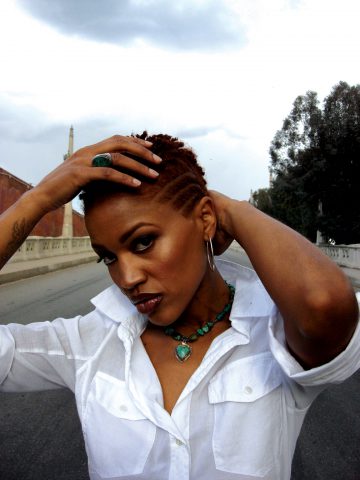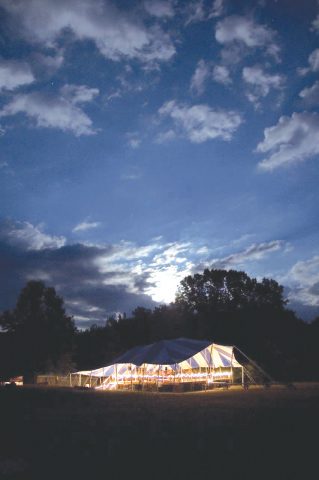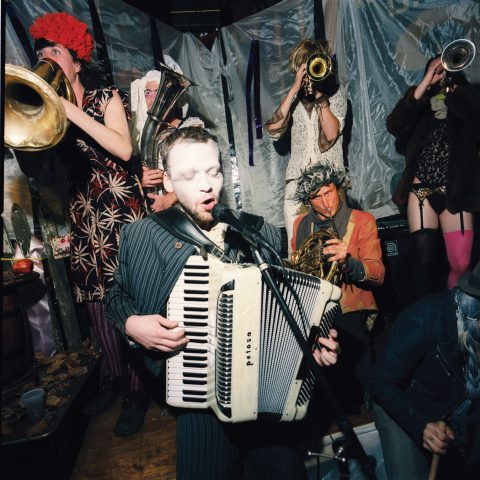In the past few years, LGBTQ music has seen a surge in visibility, with everything from mainstream festivals such as the True Colors Tour and the DIY venture of Mondo Homo Dirty South (which first took place in Atlanta during the U.S. Social Forum in June 2007) to MTV Networks’ Logo (which, according to their website, has given “the LGBT world…a place all its own.”) But where does that leave the musicians? Signing multimillion-dollar record contracts? Hardly. Creating community and record-industry revolution every step of the way? Without a doubt.
First, a word on semantics: It’s difficult to choose just one term to describe this entire genre of music. Gay? Lesbian? LGBT? Acousti-Homohop Womyn-Electro Dance-Trance Punk Rock? For the purposes of this article, let “queer” suffice to describe a genre defined by a lifestyle which includes all “types” of alternative viewpoints and political persuasions, regardless of sexual orientation per se. Through several discussions with integral members of the queer music community, a common thread emerges among most queer musicians: politics, above and beyond LGBTQ rights. According to Gina Mamone, founder of Riot Grrrl Ink, the largest queer record label in the world, “Anytime we look at where we’re similar, instead of where we’re different, and start to relate, then we begin to talk about the more difficult issues, like reproductive rights and the environment.”
Homo-A-Gogo (HAGG), a music festival that began in Olympia in 2002, is a perfect example of how music can unite musicians in the creation of social change. Not only does HAGG benefit the Gender Variant Healthcare Project, it also includes workshops, community building and cultural activism. Better yet, it’s a place for everyone. As Ed Varga, HAGG’s founder, puts it, “One of the main core values of Homo-A-Gogo is if you feel like this is your community and this is where you belong, then you belong here.”
Queeruption, an international festival with similar politics, includes a direct political action in which most, if not all, of the festival-goers participate. The 2007 festival took place in Vancouver and the participants held an action at the nearby Chapman Creek Watershed to prevent old growth trees from being logged. Even exclusive festivals like the annual Michigan Womyn’s Music Festival, which admits only “womyn-identified womyn,” or Melissa Etheridge’s first annual Sugarbush Music Festival & Women’s Cultural Fair, which will take place in April 2009, promote political expression. MichFest’s roster of workshops include “Radical Activism and Organizing” and “The Matrix of Oppression.” The full event schedule for Sugarbush has yet to be released, but based on Etheridge’s website, it will likely focus on green activism.
Mainstream, corporately backed organizations like Logo or the True Colors Tour also pack a political punch, albeit a less radical one. Cindy Wonderful of Scream Club, the queer-electro-hip-hop group of Olympia, Washington, talks about mainstream culture being just as important as radical DIY communities because there are populations who don’t have access to information about festivals like Mondo Homo. While her band is deeply immersed in queer culture, she says, “I want to be on Logo because I want to be the band that some kid somewhere who doesn’t have any reference point for anything can see and be opened up to another world. If there are more gay people in mainstream media, then eventually we’ll get to issues of class or gender.”
Sometimes the radical aspects of queer music are not just presented through direct action and politics. Touring LGBTQ artists not only create alliances within their own communities, but their performances sometimes create safe spaces for lesbians to gather that otherwise wouldn’t exist, especially in rural communities and for the groups of queer youth that Wonderful mentions, who don’t have access to much more than the mainstream. Sometimes just showing up to create a safe space is more important than pushing a particular political platform.
However, it’s possible to do both at the same time, as in Homorevolution, an eight-city tour through the Southwest that took place in 2007 and claims to be the first ever “homohop” tour, despite the fact that the term has existed for years. Tori Fixx, an artist on the tour, states in an interview with the Minnesota Daily, “Hip-hop, more than any other musical genre, is blatantly misogynistic and homophobic.” The tour aims to use hip-hop as a tool to not only increase visibility of the LGBT community within the genre, but also to talk about the original struggles on which hip-hop was founded. Camilo Avenar, creator of Homorevolution, says in the same article, “This is hip-hop…it’s confronting social problems, fighting oppression through music, challenging mainstream ideas.”
Serafemme Queer Women of Color Music Festival in Hollywood, California is another festival vying for visibility of an underrepresented community. This month’s festival features headliners Natalie “the Floacist” Stewart of Floetry, and a performance by Deepa Soul and Sisters in the Pit.
LGBTQ festivals and TV channels are not the only elements affecting the rapidly changing queer music scene. On the recording side of the industry, rather than that of direct action and performance, two key pieces are pushing the boundaries even further: technology and record labels. Computer software such as Garage Band and ProTools are becoming increasingly accessible, which means that just about anyone with something to say can set up in their kitchen and record music. Social networking sites such as MySpace, Reverb Nation and Facebook make marketing, reaching fans and booking tours easier than ever.
Queer record labels, or labels that actively sign and promote queer artists, are also becoming increasingly ubiquitous. For example, Bitch’s Short Story Records produced Ferron’s latest record; Megan Birdsall’s Don’t Stop Believin’ Records supports Team Gina and Cindy Wonderful’s Crunks Not Dead has signed a number of queer artists, including Nicky Click, Jenna Riot and Johnny Dangerous. Riot Grrrl Ink founder Gina Mamone has based her label on a “radical capitalist structure” in which the artists keep 100 percent of the revenue, and locates the future of queer music in finding sustainable ways to create political art and music while considering the bigger picture. This year the label will create the first ever 100-percent carbon-balanced recording by purchasing shares of Terrapass, an organization that invests in carbon reduction projects such as clean energy, landfill gas capture and farm power. The label also used Terrapass to offset the carbon emissions produced from the over 100 touring acts in their roster.
As with anything, there are also problems within the queer music community. Do Budweiser and American Airlines, who sponsor Pride and a handful of mainstream festivals, see us as anything more than a marketable audience? Perhaps not. Is every event 100 percent accessible by the entire queer community? No, but that’s not the point. The point is that in an increasingly volatile political landscape, queer musicians are gaining a foothold through their art by wearing their hearts on their sleeves and delving into issues that affect everyone’s daily lives.
Amy Ray puts it best in the short video about Homo-A-Gogo: “Radical queer artists have a very important thing to say, and they open the gates for people that are different, and youth, and breaking down gender and race and class.”
To reiterate Ed Varga’s sentiment, if this is the music that speaks to you, then this is where you belong. If you think it’s not quite right, then press “record” and put your music where your mouth is.





What Do You Think?